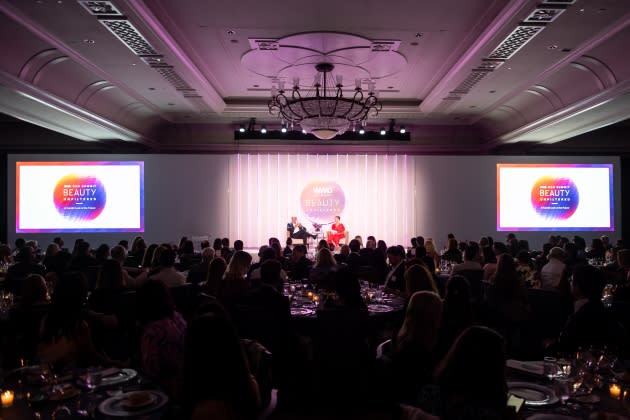The 2022 WWD Beauty CEO Summit: Beauty’s Big Reframe

Beauty is abuzz with possibility and potential.
As the industry came together for the 2022 WWD Beauty CEO Summit, held May 9 to 11 at the Ritz-Carlton in Key Biscayne, Fla., the energy was electric.
More from WWD
The presenters represented all areas of the industry — brands, retailers, big tech, investors, inventors, entrepreneurs and leading executives, and the audience, the largest for a Beauty CEO Summit, was equally as varied.
The theme of the conference, Beauty Unfiltered: A Candid Look at the Future, addressed both the explosive growth and extreme volatility in the industry today, or, as Stéphane de La Faverie, group president of the Estée Lauder Cos., called it, “the new normal that seems abnormal.”
The description seems more than apt. On the one hand, there’s been a proliferation of new brands, dynamic retail developments and a collective consumer shift in the way that people are thinking about their wellness and self care. On the other, forces like COVID-19, climate change and geopolitical unrest continue to disrupt business around the globe, while the social justice movement has accelerated the drive for a truly inclusive and equitable industry.
Add on top of that, the dawning of a new digital age and the emergence of the metaverse, and what comes through is an industry at a crossroads. As Meta’s Karin Tracy said, “Every 10 to 15 years, there is a major technological advancement that changes the game. This is one of those moments.”
It was a moment not lost on the 35 speakers. While many different themes emerged during the Summit, there was also a common thread: These are leaders who don’t react to change — they create it.
Here, the top 10 takeaways from the 2022 WWD Beauty CEO Summit, with in-depth coverage on the pages that follow.
Beauty is a vibe: Beauty isn’t about physical appearance any longer. Consumers today are looking to connect through the power of purpose and a feeling of self-fulfillment, celebrating their individuality while opening their arms to a community that is inclusive, rather than exclusive. In the words of superstar entrepreneur Pharrell Williams, “Beauty is a spiritual thing. You can see someone who is textbook beautiful, but it’s what comes out of their mouths or the energy that they vibrate that tells you if they’re really beautiful.”
Brick-and-mortar is back: While e-commerce sales boomed during the pandemic, physical stores still account for about 70 percent of beauty transactions, according to NPD’s Larissa Jensen. That being said, stores have to evolve to provide a compelling reason for consumers to come. No surprise then, that Sephora CEO Martin Brok teased that retailers entry into services.
Hello biology, goodbye chemistry: As advances in biotech enable companies to use fermentation to make ingredients that are safe, sustainable and repeatable, look for the decline of petrochemical-based products and processes.
Today, every market is an emerging market: While the rise of the middle class in countries like China and India means there is a shifting center of gravity from West to East, winning in mature markets means applying the same level of granularity to understanding preferences and nuances in every market you do business in.
Data, data, data…: Harness the power of big data to understand what consumers want — before they even know they want it.
…But make it human: That being said, savvy marketers are learning data analytics can’t replace the insights that come from IRL interactions with consumers. P&G Beauty, for example, lives permanently in “#consumerobsession mode,” said Markus Strobel, president of skin and personal care, joking that “the hashtag is just there to make it sound a bit cool.”
Hands off: While the M&A landscape shows no signs of waning, the way that big companies are approaching acquisitions has changed considerably. Gone are the days of corporatization in the name of synergy, in favor of an approach that allows brands to operate independently of the mothership. “It’s a partnership of values, humility,” said Unilever’s Vasiliki Petrou. “They understand better than anybody else because they have created the brands.”
The big blur: As retail channels intersect and product categories merge, next-gen founders are rewriting the go-to-market rules that have long dominated the industry. Brands no longer feel beholden to staying in one lane when it comes to products or channels — they’re going where the consumer wants them to head.
The democratization of wellness: Once primarily the province of the privileged, wellness is entering the mainstream thanks to a consumer attuned to the necessity of self care, both physical and mental, and retailers looking to create more meaningful connections with shoppers. For Sephora, it represents the future. “It is truly about well-being,” Brok said. “We collectively have an opportunity to think about what that will look like. It’ll start small at first, like the hair category, which five years ago was minuscule in prestige beauty,” he continued. Not for long though. “It’s absolutely explosive,” Brok said. “Watch this space.”
Longevity is the new antiaging: Rather than turning back the hands of time, marketers today are focused on maximizing them. As advances in science and medicine enhance our knowledge of the aging process, beauty will benefit. Said Charles Rosier, CEO of Augustinus Bader, “The focus is on the convergence of health, beauty and longevity.
Sign up for WWD's Newsletter. For the latest news, follow us on Twitter, Facebook, and Instagram.

